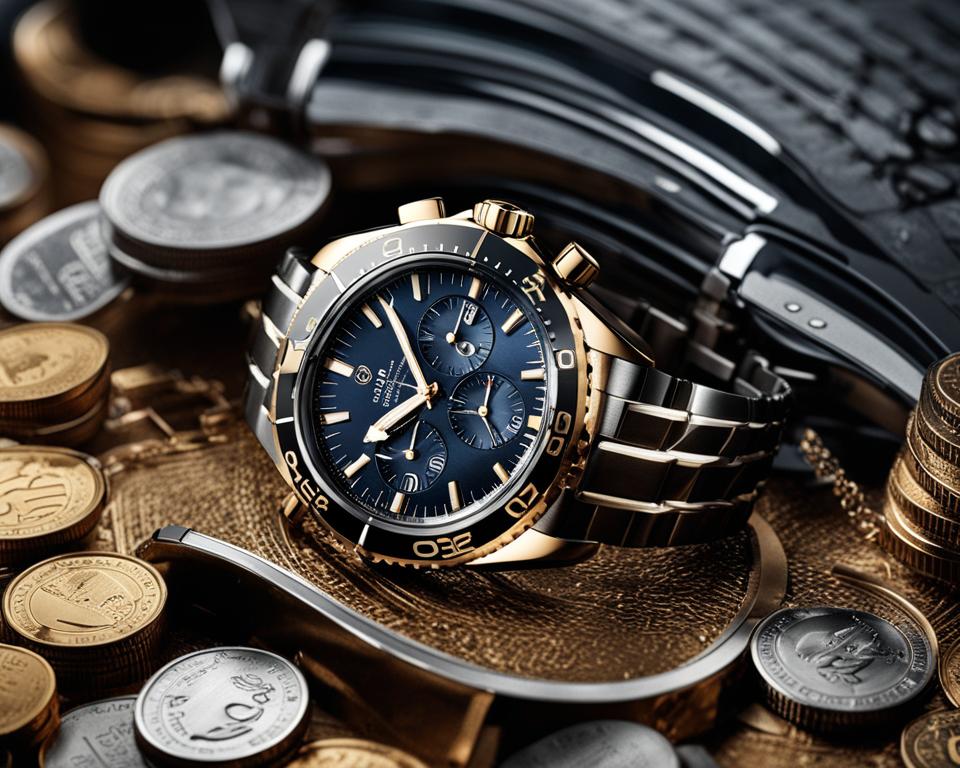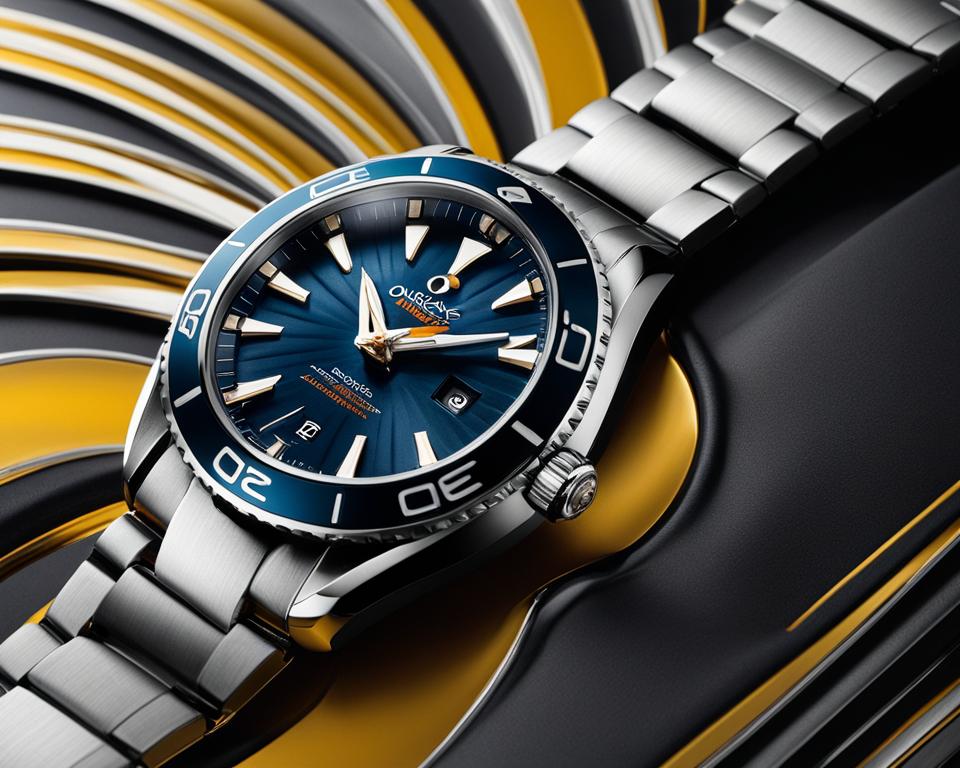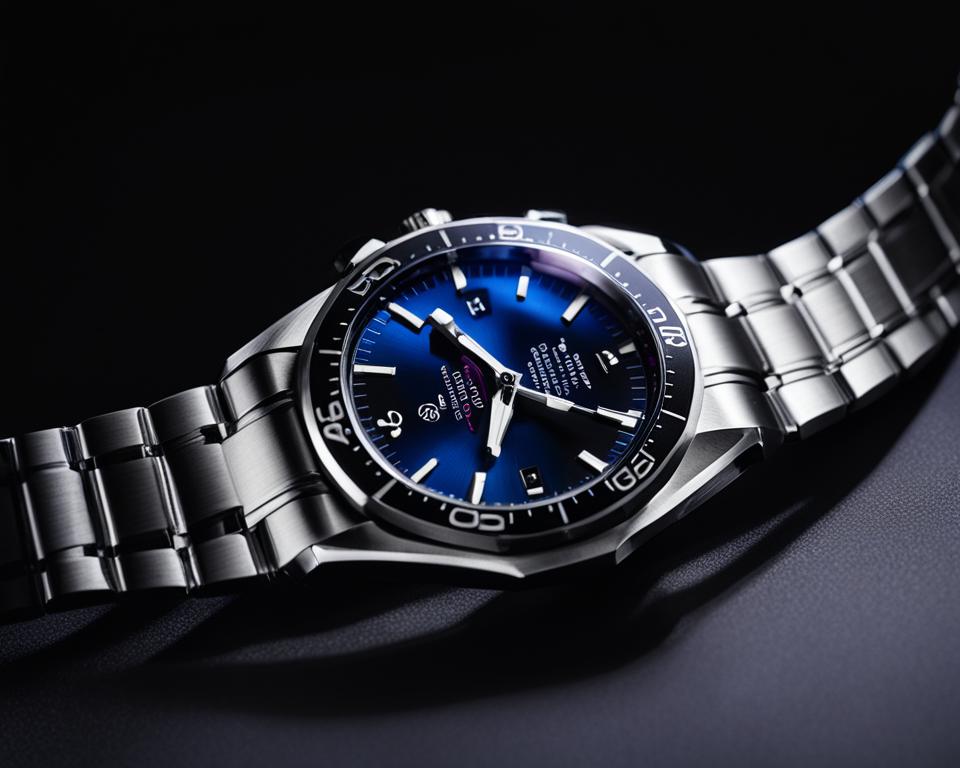The threat of magnetism has long been a challenge in the world of watchmaking. Magnetic fields can negatively impact the performance and accuracy of mechanical watches. Over the years, Omega has developed innovative solutions to combat this issue. From using palladium and soft-iron shields in the early 20th century to incorporating silicon and non-ferrous materials in their modern watches, Omega has consistently pushed the boundaries of anti-magnetic technology. Today, their timepieces can withstand magnetic fields greater than 15,000 gauss, providing unparalleled precision and durability.
Key Takeaways:
- Omega watches are equipped with advanced anti-magnetic technology to protect against the negative impact of magnetic fields.
- Historically, Omega has pioneered the development of anti-magnetic watches, incorporating innovative materials and designs.
- The Seamaster Aqua Terra is one of Omega’s standout models, offering exceptional magnetic resistance without compromising on performance or aesthetics.
- Omega’s commitment to anti-magnetic technology ensures the durability and precision of their watches, even in the presence of strong magnetic fields.
- The brand continues to push the boundaries of anti-magnetic watchmaking, aiming to introduce new technologies and materials to enhance magnetism resistance in their timepieces.
A Brief History of Anti-Magnetic Watches
The history of anti-magnetic watches dates back to the early 20th century. In 1915, Vacheron Constantin and Tissot introduced anti-magnetic pocket watches. These timepieces used palladium in the construction of the escapement to protect against magnetism. During World War II, watches designed for pilots, such as the IWC Mark XI, featured soft-iron cages to shield the movement from magnetic fields at high altitudes. In the 1950s, Omega, IWC, and other brands introduced watches capable of withstanding magnetic fields around the North Pole. These early anti-magnetic timepieces laid the foundation for the advanced technology found in Omega watches today.
To combat the detrimental effects of magnetism on watch movements, watchmakers realized the need for innovative solutions. By incorporating anti-magnetic materials and designing protective cases, watch brands like Omega have developed timepieces that offer exceptional resistance to magnetic fields.
Evolution of Anti-Magnetic Technology
Omega’s commitment to anti-magnetic technology can be traced back to their early innovations. In the 1950s, they introduced the Railmaster collection, which featured a soft-iron inner case to shield the movement from magnetic fields. This was a significant breakthrough at the time.
Over the years, Omega continued to refine their anti-magnetic technology. In 2013, they unveiled the pioneering Omega Master Co-Axial movement. This revolutionary movement can withstand magnetic fields greater than 15,000 gauss, far surpassing the industry standard. By using non-ferrous materials and silicon components, Omega eliminated the need for a protective cage, allowing for transparent casebacks.
| Year | Development |
|---|---|
| 1915 | Introduction of anti-magnetic pocket watches by Vacheron Constantin and Tissot |
| World War II | Pilots’ watches with soft-iron cages for magnetic shielding |
| 1950s | Omega, IWC, and other brands develop watches resistant to magnetic fields around the North Pole |
| 2013 | Omega introduces the Master Co-Axial movement with a magnetic resistance of over 15,000 gauss |
By integrating cutting-edge materials and engineering techniques, Omega has established itself as a leader in the field of anti-magnetic timepieces. These watches not only provide unparalleled accuracy and performance but also showcase the brand’s dedication to pushing technological boundaries.
Omega’s Breakthrough Technology
Omega’s commitment to anti-magnetic technology has propelled them to new heights in recent years. In 2013, they introduced the groundbreaking Master Co-Axial movement, which boasts impressive resistance to magnetic fields up to 15,000 gauss. This remarkable achievement was made possible through the utilization of advanced materials, including silicon and anti-magnetic alloys, within the movement.
By incorporating these cutting-edge materials, Omega has successfully eliminated the need for a traditional soft-iron cage, allowing their watches to feature transparent casebacks. This innovative design not only enhances the aesthetics of the timepiece but also showcases the exceptional technology within.
The Master Co-Axial movement, combined with other advancements such as the Si14 silicon balance spring, ensures unrivaled performance and durability in Omega watches. The use of silicon in the balance spring reduces the effects of external disturbances, resulting in increased accuracy and precision.
With their commitment to excellence, Omega aims to incorporate this breakthrough anti-magnetic technology into all their movements by 2020, solidifying their position as leaders in the industry.

Omega’s Revolutionary Seamaster Aqua Terra
One of Omega’s most remarkable achievements in anti-magnetic watchmaking is the Seamaster Aqua Terra. This timepiece is resistant to magnetic fields in excess of 15,000 gauss, surpassing any previous watch in terms of magnetic resistance. The Aqua Terra features a Co-Axial caliber 8508 movement, which is made of non-ferrous materials to eliminate the need for a protective container.
This innovative design not only ensures superior anti-magnetic performance but also allows for a sapphire crystal exhibition caseback, showcasing the beauty of the movement. With its timeless aesthetics and exceptional magnetism resistance, the Seamaster Aqua Terra is a true horological triumph.
| Omega’s Revolutionary Seamaster Aqua Terra | |
|---|---|
| Magnetic Resistance | In excess of 15,000 gauss |
| Movement | Co-Axial caliber 8508 |
| Materials | Non-ferrous |
| Caseback | Sapphire crystal exhibition |
Omega’s Seamaster Aqua Terra surpasses all expectations with its ability to withstand extreme magnetic fields, setting a new standard for anti-magnetic watches. The use of non-ferrous materials in the Co-Axial caliber 8508 movement eliminates the need for a protective container, allowing for a transparent sapphire crystal exhibition caseback. This design not only showcases the intricate mechanics but also reinforces the exceptional magnetism resistance of the timepiece.
Whether you’re an avid explorer or simply appreciate the craftsmanship of a fine watch, the Seamaster Aqua Terra is the perfect choice. Its stunning design, coupled with its superior anti-magnetic properties, ensures both style and functionality in one remarkable timepiece.
Omega’s Superior Anti-Magnetic Technology
What sets Omega watches apart from the competition is their dedication to incorporating state-of-the-art anti-magnetic technology. By utilizing non-ferrous materials and advanced movement design, Omega has successfully created timepieces with unparalleled magnetic resistance. The Seamaster Aqua Terra exemplifies Omega’s commitment to innovation and durability, making it a must-have for watch connoisseurs and horology enthusiasts.

The Future of Anti-Magnetic Watches
Omega has always been at the forefront of watchmaking innovation, and their commitment to anti-magnetic technology is no exception. With their relentless dedication to research and development, Omega has made groundbreaking advancements in magnetism resistance, ensuring that their watches continue to perform at the highest level.
Looking towards the future, Omega plans to further enhance the anti-magnetic capabilities of their timepieces. By leveraging their expertise in materials science and watchmaking technology, they aim to introduce new technologies that not only improve accuracy but also enhance overall performance.
One area of focus for Omega is the development of new materials. By exploring innovative alloys and non-ferrous compounds, they can create watch components that are even more resistant to magnetic fields. This will ensure that their watches remain accurate and reliable even in the face of the most challenging magnetic environments.
In addition to material advancements, Omega is also working on revolutionary movements that incorporate cutting-edge anti-magnetic technology. By refining their Co-Axial escapement and integrating anti-magnetic materials into the movement, Omega aims to achieve unparalleled precision and durability for their timepieces.
FAQ
How do Omega watches defy magnetism?
Omega watches use innovative technologies and materials such as silicon and non-ferrous materials to combat the negative impact of magnetic fields on the watch’s performance and accuracy.
Can Omega watches withstand high levels of magnetism?
Yes, Omega watches are designed to withstand magnetic fields greater than 15,000 gauss, ensuring unparalleled precision and durability.
What is the history of anti-magnetic watches?
The history of anti-magnetic watches dates back to the early 20th century, with brands like Vacheron Constantin, Tissot, and Omega introducing innovative solutions to protect against magnetism.
How do Omega watches achieve exceptional anti-magnetic performance?
Omega watches achieve exceptional anti-magnetic performance through the use of the Master Co-Axial movement and advanced technologies like the Si14 silicon balance spring, eliminating the need for a soft-iron cage.
What is special about the Omega Seamaster Aqua Terra?
The Omega Seamaster Aqua Terra is a remarkable timepiece with resistance to magnetic fields exceeding 15,000 gauss. Featuring a Co-Axial caliber 8508 movement made of non-ferrous materials, it sets a new standard for magnetism resistance.
What does the future hold for Omega’s anti-magnetic watches?
Omega continues to push the boundaries of anti-magnetic technology, aiming to further enhance the anti-magnetic capabilities of their watches and introduce new technologies that improve accuracy and performance.

Leave a Reply